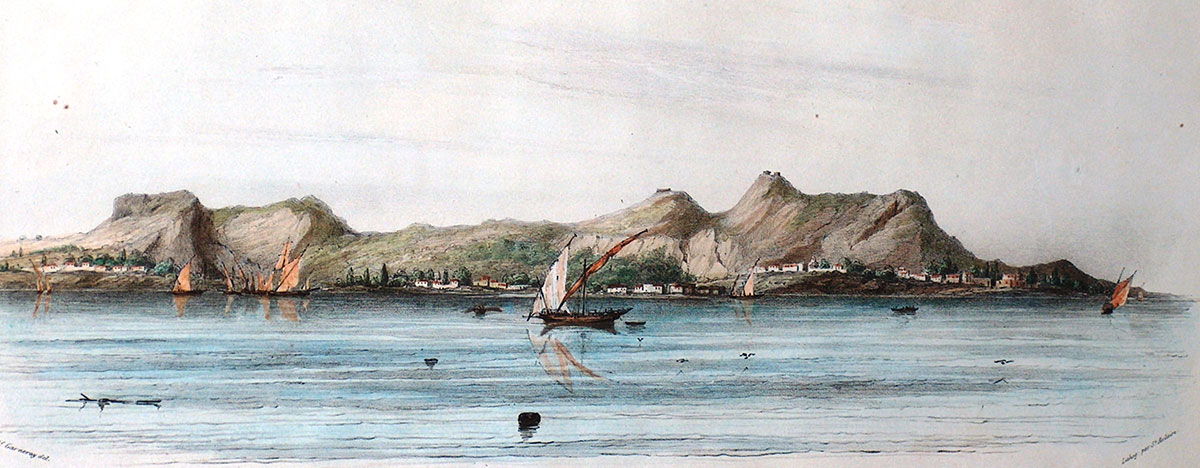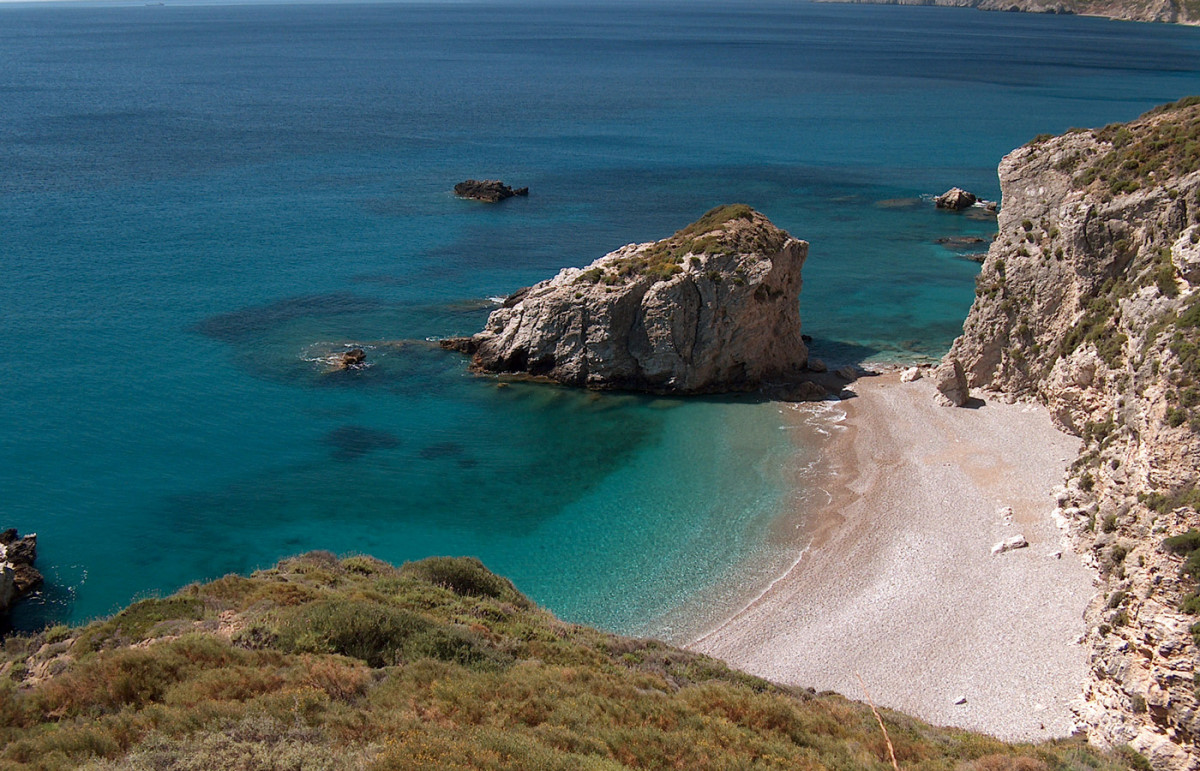From the Birth of Aphrodite to Today
According to Hesiod the sea of Kythera is the birthplace of goddess Aphrodite (Venus). Gaia (the Earth) wanted to punish her husband Uranus (the Sky) for forcing her to keep her children within the bowels of the Earth, so she called on them to help her get rid of their “wild” father. Cronus took a weapon and severed his father’s genital organs, which fell into the sea of Kythera. The foam thus formed traveled by force of wind to the island of Cyprus, where Aphrodite came forth. The island of Kythera is at the crossroads of Mediterranean thoroughfares. It was probably during the Neolithic Period (towards the end of the 5th millennium B.C.) that the first inhabitants arrived in Kythera, as evidenced by the few pottery vases found in the cave of Agia Sophia in Kalamos. Before this, archaeologists believed Kythera’s earliest inhabitants dated back to the 4th millennium B.C., based on discoveries in the cave of Chousti in Diakofti and in the area surrounding Palaiapolis. The number of villages on the island grew significantly during the protohelladic period (3rd millennium). Towards the end of the 3rd millennium B.C. the Minoans extended their domination to Kythera, controlling the area and creating a maritime trading point in Palaiapolis, where there was once a bay (now covered with earth). Kythera is also one of the strategic sites in the Minoans’ fight against piracy in the Aegean Sea. In Vuono (also called Agios Giorgios) archaeologists found signs of a Minoan “summit sanctuary”, which served three different purposes: it had a religious function, it served as an observatory, and as a “lighthouse” for maritime navigation. In the late 15th century B.C. the Minoan colony followed the decline of Minoan Crete’s metropolitan territories, and it was exactly at that time that the Mycenaeans arrived on the island. As the Mycenaean empire declined the Dorians colonized the island (around the end of the 12th century B.C.); Kythera was then subordinated to the city-state of Argos. The time at which the Phoenicians arrived on the island still remains a mystery; this people had mastered the much sought-after art of extracting a dark red color from a rare mollusk called “porphyry” (Molinus brandaris). This color is one of the most expensive export commodities. According to Herodotus the creation of Aphrodites’s sanctuary is the work of the Phoenicians, who brought the worship of goddess Astarte in from the East.
In the middle of the 6th century B.C. and following the occupation of Mount Parnonas, Kythera was under Spartan sovereignty. In 424, during the Peloponnesian war, the Athenians occupied the island, which was delivered to the Spartans in 421 under the terms of the Nicias peace treaty. Under its Spartan domination the island was influenced by the worshipping of the Spartan pantheon, the Dioscuri, Alea, Poseidon (God of the Earth) and Hercules. As of the middle of the 5th century B.C. the god Asclepius was one of the gods worshipped in Kythera, under his Laconian name, Aiglapios. In the 2nd century B.C., with the uprising of the “Free Laconians”, Kythera became independent; the inhabitants minted their own coins. As the Roman Empire expanded to the East, Kythera lost its strategic importance, and life on the island experienced no particular events. The maritime city of Scandia was completely destroyed by a massive earthquake in 375 A.D. All the buildings were wiped off the map and the ensuing tidal wave radically changed the shoreline.
In 395 A.D. Kythera formed an integral part of the Eastern Roman Empire. According to the excavations of both Huxley and Coldstream in Kastri the area of Palaiapolis was inhabited and served as a harbor until the 6th century A.D. In 673 the Arabs landed on the northern shores of the island of Crete and further attacked Kythera, wiping Scandia, its harbor and its fortifications off the map. After the second half of the 7th century Kythera was on a downfall.
For about three centuries the island of Kythera was not mentioned in the outside world. As of 825 Crete was wholly occupied by the Arabs, while the Saracen pirates who had settled there were launching expeditions in neighboring areas, including the sea of Kythera, where they spread terror. Piracy as well as the attacks by the Arabs in the Eastern Mediterranean did not help populations to settle on the island’s shores. In 961 A.D. the Byzantine Emperor Nikephoros Phokas took over Crete from the hands of the Arab rulers. In the 12th century the Eudaimonogiannides came to Kythera from Monemvasia, where they stayed until 1204. One of the first villages on the island was probably Kolokythia, in the small bay of Agia Patrikia. However, the main fortification was established in Agios Dimitrios, today known as Palaiachora (which means “old capital”). As of the 10th century several Christian churches were erected in Kythera, such as Agios Andreas in Livadi, or Agios Dimitrios in Pourko. Population was also on the rise. In the 13th century, at the end of the 4th Crusade (1201-1204), the Venetians, who had already established a powerful State, annexed Kythera as well as other Greek islands and regions. This took place at the same time as the Occupation of Constantinople in 1204. In 1207 the Venetian State set the Venieri family on the island; the Venieri stayed in control of both Kythera and Western Crete for several years.
The feudal system became established in Crete and Kythera. 1207 marked the beginning of a period of six centuries of Venetian sovereignty on Kythera and on the islands of the Ionian Sea. In 1238, weighing the importance of Venetian sovereignty in the area, Nikolaos Eudaimonogiannides decided to offer his daughter’s hand to the son of Crete’s Venetian governor, a Venieri; Kythera was nominally under Venetian sovereignty. From 1275 to 1308 the Byzantines took over the control of Kythera and assigned the island’s governance to Pavlos Notaras, who hailed from Monemvasia. During that time the Byzantine Empire was led by Michael Palaialogos VIII (1259-1282). Following imperial directives, Malvasian governors (from Monemvasia), headed by the Notaras family, evicted the Venieri family and established the Byzantine order. However, the Venieri came back to the island in 1308, wishing to colonize the island with new families. In 1316 the Kasimatis family settled on the island, along with several families of the Mani region. The Venetians subsequently launched a war over the entire Aegean Sea. In 1363 the whole of Kythera fell into the hands of the Venetians; aristocrats settled in Kythera’s new city, Chora, the current capital city, while the Byzantine capital, Agios Dimitrios (today known as Palaiachora), founded by the Eudaimonogiannides, lost its pre-eminence. The Notaras then deserted the island. In the 16th century the island’s population was probably around 4,000. In order to better protect themselves against invasions the inhabitants set up three fortified hubs: Agios Dimitrios (today known as Palaiachora), Mylopotamos in Kato Chora, and Chora (the current capital city).
In 1537 Hayreddin Barbarossa, Grand Admiral of the Ottoman Empire and privateer along the shores of Berber country, destroyed and plundered Palaiachora, killing several civilians and selling those captured as slaves. Palaiachora was abandoned for good. The surviving families went to live in nearby villages. During the final years of Venetian sovereignty the island’s population reached 7,500. When Napoleon the Great abolished the Venetian State in 1797 Kythera ceased to be the property of the Republic of Venice. From that point onwards, and according to the terms of the Treaty of Campo-Formio, Kythera and all the islands of the Ionian Sea came under French sovereignty. In 1797 Vincent Renaud conquered Kythera and the new middle class, with the help of farmers, burned the “Libro d’Oro”, the Book of Nobles, on Estavromenos Square in Chora.
In 1798 the French planted the Tree of Freedom in Estavromenos Square in Chora, proclaiming the French Revolution’s ideals: “Liberty, Equality, Fraternity”. Meanwhile, the wave of emigrating Kythereans towards Smyrna had already begun. Shortly after, between 1798 and 1799 the Russians and the Turks united to conquer Kythera and the Ionian islands. Besieged, the small French garrison was forced to surrender the castle to the Russian fleet. The Treaty of Constantinople established the “Islands of the Ionian Sea” as a semi-independent State. However, the preservation of the aristocrats’ privileges was hardly to the liking of either the middle class or the villagers, who threw the doge and other aristocrats out, plundering their wealth. On 12 May 1799, during the celebration of Saint Theodossios’s day, two other aristocrats were killed. Later on, with the Treaty of Tilsitt in 1807 the islands returned under French control for two years (1807-1809), before falling into the hands of the British. On 20 November 1815, with the Treaty of Paris, the “United State of the Ionian Islands” was established, both a federal democracy and a British protectorate. Its capital was the city of Corfu, on the island of the same name. The British built several structures on Kythera, with the inhabitants serving as forced labor. On 26 August 1817 the Ionian State gave itself a constitution, albeit still under British influence.
During the Greek Revolution of 1821 several emigrants from Peloponnesia sought refuge in Kythera. Conversely, many Kythereans were leaving for Peloponnesia to help in the fight for independence. During the following years, after the territories were liberated, a number of Kythereans left the island to find work in the free Greek State, in Crete or in Smyrna.
On 28 May 1864 the Heptanese (the six islands of the Ionian Sea plus Kythera) joined liberated Greece. In 1903 a massive earthquake struck Kythera, resulting in the destruction of the village of Mitata, as well as several other houses throughout the island. From an administrative point of view, Kythera belonged to the region of Argolid – Corinth, then to the region of Laconia, then together with Antikythera both islands formed a fully-fledged region, before being incorporated into Attica, a situation that has remained unchanged up until today.
In the early 20th century major waves of emigrants left for Australia and the United States. In 1916 a garrison of some 200 soldiers from a Cretan battalion occupied Kythera on behalf of the “Government of National Defense”, which was based in Salonika. Its commander-in-chief was Eleftherios Venizelos. Secret discussions with Panayotis Tsitsilias, Member of Parliament and supporter of Venizelos, eventually led Kythera to proclaim the “Autonomous Administration of Kythera” on 17 February 1917. They sided with the Government of National Defense and with Eleftherios Venizelos, against the King. At the time we were in the middle of the First World War and Venizelos supported the major powers, the United Kingdom, France and Russia, known as the “Entente Cordiale”. On the other hand, the State of Athens (Venizelos was based in Salonika) and the King supported Germany. The “Autonomous Administration of Kythera” thus declared war on the Germans. Access to the western side of the Aegean Sea was controlled by the Allies, and this played a huge part in the outcome of the war.
During the Second World War a number of Kythereans joined the Greek resistance. On 10 May 1941 the island was occupied by the Germans and the Italians. In the village of Potamos and with the help of Peloponnesian rebels, a resistance front was set up. This group’s actions resulted in weakening the Germans’ control of the island. On 4 September 1944 the last Germans were ousted from Kapsali, as resistance fighters forced them to leave their final positions and to flee Kythera. Kythera was the first Greek region to be liberated by Axis forces. Ten days later, on September the 14th, Ally ships were sailing into the free bay of Kapsali. After the war most of the younger population left the island’s marginal lands, some going to Athens, others to Australia and the United States in search of a better life.
Emigration to foreign countries ended in the late 1970s. However, it was only in the early 1990s that urbanization, which had started in the 1950s, was completed, leading a number of Kythereans to depopulate rural areas. It was during those years that the island’s tourism industry started to develop. The “Capodistria” law unified the island’s thirteen communities, forming the City Hall of Kythera. Today, the island is forced to keep up with a development moving at dizzying speed. In their search for a path that will help them preserve both their identity and their environment, modern-day Kythereans are compelled to take decisions that make the island’s individuals, citizens, and inhabitants their main interest. The island of Venus has not been spared by the drive for illicit profits and unabashed development. Kythera must avoid a new “invasion attack” at all costs. History moves on and those who are to write it need to make wisdom their guide…




